
Portland Union Station is a train station in Portland, Oregon, United States, situated near the western shore of the Willamette River in Old Town Chinatown. It serves as an intermediate stop for Amtrak's Cascades and Coast Starlight routes and, along with King Street Station in Seattle, is one of two western termini of the Empire Builder. The station is a major transport hub for the Portland metropolitan area with connections to MAX Light Rail, the Portland Streetcar, and local and intercity bus services. The station building contains Wilf's Restaurant & Bar on the ground level and offices on the upper floors. It also has Amtrak's first Metropolitan Lounge on the West Coast, which is reserved for first-class sleeping car and business-class passengers.

The Georgetown Loop Railroad is a 3 ft narrow gauge United States heritage railroad located in the Rocky Mountains in Clear Creek County, adjacent to Interstate 70 in Colorado.

Winona station, formerly known as the Chicago. Milwaukee & St. Paul Railway Station, is a historic train station in Winona, Minnesota, United States. It is served by Amtrak's daily Empire Builder service. It was originally built in 1888 by the Chicago, Milwaukee, St. Paul and Pacific Railroad, known later as the Milwaukee Road. A former Milwaukee Road freight house also exists here.
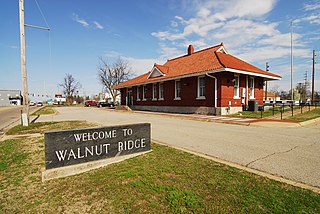
Walnut Ridge is a train station in Walnut Ridge, Arkansas, United States, that is currently served by Amtrak, the national railroad passenger system. It was originally a Missouri Pacific Railroad station and has been listed on the National Register of Historic Places since 1992.

The Geraldine Milwaukee Depot was built by the Chicago, Milwaukee, St. Paul and Pacific Railroad in 1914. The depot is a rectangular one-story wood-frame building built in the Craftsman style.
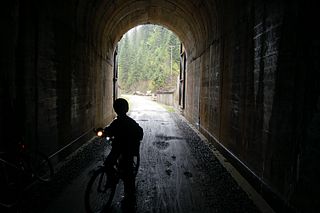
The Chicago, Milwaukee, St. Paul and Pacific Railroad Company Historic District consists of the historic right-of-way of the Chicago, Milwaukee, St. Paul and Pacific Railroad in the Bitterroot Mountains from East Portal, Montana, to the mouth of Loop Creek, Idaho, a distance of 14.5 miles (23.3 km). The district was once part of the railroad's mainline from Chicago, Illinois to Tacoma, Washington.

The Portland and Southwestern Railroad Tunnel, also known as the Nehalem Divide Railroad Tunnel, is an abandoned railroad tunnel near Scappoose, Oregon, United States, that is listed on the National Register of Historic Places. The tunnel was driven by the Portland and Southwestern Railroad, whose chief business was logging. Unusually for a logging railroad, the Portland and Southwestern built tunnels. In order to reach the far side of the Nehalem divide in the Northern Oregon Coast Range, the railroad undertook a 1,712-foot (522 m) tunnel. Some work was started in 1910, but most work began in 1918 and was completed in 1919. Since the tunnel was not through solid rock, the tunnel was lined with timber. The tunnel was used until 1945, when it was replaced by a truck road over the divide.
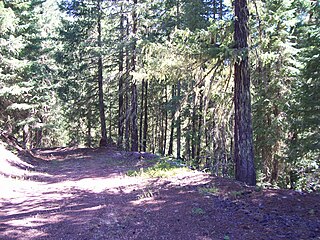
Oregon Pacific Railroad was a railroad in western Oregon, United States, from 1880 to 1894, when it was sold to the Oregon Central and Eastern Railroad. A substantial part of the Oregon Pacific's abandoned right-of-way is preserved as Oregon Pacific Railroad Linear Historic District.

Alaska Central Railroad Tunnel No. 1, also known as the Loop District Tunnel No. 1 is a historic railroad tunnel located about 40 miles (64 km) north of Seward, Alaska, in the Placer River Valley, Kenai Peninsula. The tunnel was dug in 1906 and served the Alaska Central Railroad and later the Alaska Railroad until the route in the area, known as the "Loop District" was rerouted in 1951.
The Grand Forks Near Southside Historic District is a 182-acre (74 ha) historic district in Grand Forks, North Dakota that was listed on the National Register of Historic Places (NRHP) in 2004.

The Northern Pacific Railroad Completion Site is the location of the golden spike ceremony for the completion of the Northern Pacific Railway (NP) in 1883. The site is located near Gold Creek in Powell County, Montana off of Interstate 90, approximately 59 miles (95 km) southeast of Missoula and 40 miles (64 km) west of Helena.

The Newport station, also known as Missouri-Pacific Depot-Newport, is a historic railroad station at Walnut and Front Streets in Newport, Arkansas. It is a long rectangular single-story brick and stucco topped by a hip roof, whose wide eaves are supported by large Italianate knee brackets. Its roof, originally slate, is now shingled, detracting from its original Mediterranean styling. A telegrapher's bay extends above the roof line on the track side of the building. The building was built in 1904 by the Missouri-Pacific Railroad to handle passenger and freight traffic.
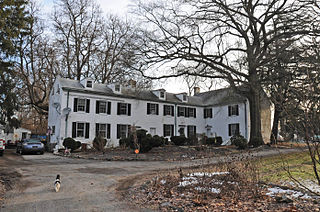
The Grantham-Edwards-McComb House is a historic house at 217 Park Avenue in New Castle, Delaware. It is a 2+1⁄2-story Federal style brick building with a side gable roof, end chimneys, and a five bay facade. It was built between 1804 and 1817 by Isaac Grantham, and was probably used as a tenant farm in its early years. After the American Civil War it was acquired by Henry S. McComb, a Civil War veteran who later was a cofounder of the Union Pacific Railroad.

Cloverdale station is a bus station and future intermodal station in Cloverdale, California. It is served by Amtrak Thruway and Sonoma County Transit buses. Additional service to Sonoma County Airport station is provided by Sonoma County Transit under contract by Sonoma–Marin Area Rail Transit.

The Hawkeye Street Underpass is a historic structure located south of Nora Springs, Iowa, United States. It spans South Hawkeye Street for 28 feet (8.5 m). The Illinois Central Railroad arrived in Nora Springs in 1868, and the Burlington, Cedar Rapids & Northern Railway (BCR&N) arrived three years later. The later was acquired by the Chicago, Rock Island & Pacific Railroad in the early 1880s. This stone masonry arch underpass was constructed by the Rock Island Line in 1889 as part of an upgrade of the tracks. It was designed by F.A. McDonald who had worked for the BCR&N. It is the only known stone arch bridge in Floyd County. The bridge was listed on the National Register of Historic Places in 1998.
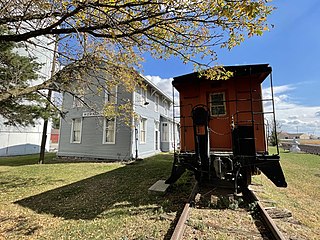
The Chicago, Milwaukee, St. Paul & Pacific Combination Depot-Hornick, also known as the Hornick Depot, is a historic building located in Hornick, Iowa, United States. The town was patted by the Chicago, Milwaukee, St. Paul & Pacific Railroad's land company when the railroad created a branch line from Manilla, Iowa to Sioux City. Completed in 1887, the railroad built this two-story frame structure to serve as its passenger and freight depot. It is one of six such depots that remain in Iowa, and the best preserved. These buildings were built from a standard design used by the railroad. The two-story stations included living quarters for the station manager because the towns had yet to develop when the depot was built. This was an island depot, with freight loaded on the north side and passengers boarded on the south. Decorative elements on this depot include lathe-turned wooden finials, angled wooden brackets, and bracketed door and window hoods. Passenger service ended in the 1950s, and grain was loaded here until 1980 when the Milwaukee Road abandoned the Sioux City branch line. The building was listed on the National Register of Historic Places in 1990. It has been converted into a local history museum.
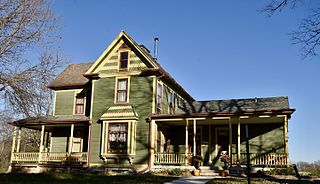
The Owen A. and Emma J. Garretson House is a historic building located east of Salem, Iowa, United States. Its significance is derived from its association with Owen Garretson, a local farmer, politician, and historian. His parents, Joel C. and Elizabeth (Goodson) Garretson, were two of the earliest settlers in Henry County, settling here in 1837. The elder Garretson's were opposed to slavery and their farm house was a stop on the Underground Railroad. Owen farmed with his father, and eventually acquired his father's farm. He was involved locally and on the state level with the People's Party, served as a county supervisor, and on the boards of local institutions. Garretson was the president of the Henry County Historical Society, and was a member of the State Historical Society of Iowa. He wrote several articles on the history of Henry County and southeast Iowa that were published in Palimpsest and the Iowa Journal of History and Politics.
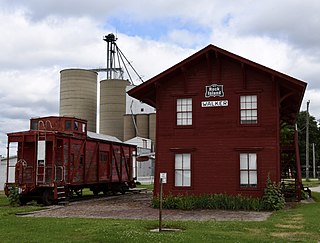
Walker Station is a historic building located in Walker, Iowa, United States. The two-story frame building with bracketed eaves was completed in 1873 along the Burlington, Cedar Rapids, and Minnesota Railway tracks. The depot also served its successor railroads: the Burlington, Cedar Rapids and Northern, and the Chicago, Rock Island and Pacific. Typical of many railroad towns in the Midwest, this is the first building that was built here and the town grew up around it. It is an example of a combination depot that was used for both passenger and freight usage in smaller communities. Because it has a ground level brick platform, service here was primary passenger and light freight service. A higher level of freight service would have required a raised platform.

The Northern Pacific Warehouse in Thompson Falls, Montana, also known as the Burlington Northern Warehouse, was built in 1900 and was listed on the National Register of Historic Places in 1986.
The Wool Warehouse, on E. Bridger in Bridger, Montana, was built around 1900. It was listed on the National Register of Historic Places in 1987.



















